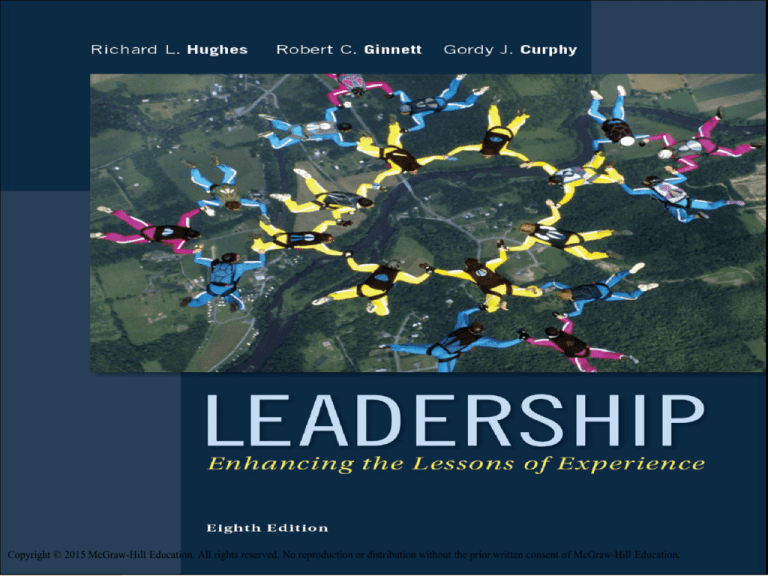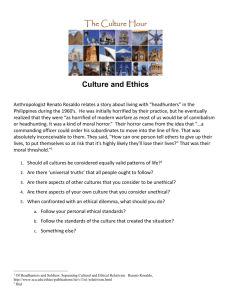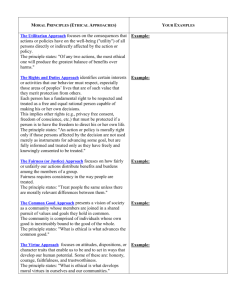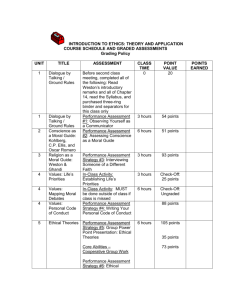
Copyright © 2015 McGraw-Hill Education. All rights reserved. No reproduction or distribution without the prior written consent of McGraw-Hill Education.
5-1
Chapter
5
Values, Ethics, and Character
“Leadership cannot just go along to
get along… Leadership must meet
the moral challenge of the day.”
~Jesse Jackson
5-2
Introduction
• Leaders can use power for good or ill will.
• A leader’s personal values and ethical code
may be the most important determinants of how
a leader exercises available power sources.
• Recent scandals involving political, business,
and religious figures highlight the need to
consider values and ethics in terms of
leadership.
• Scholarly and popular literature have turned
greater attention to the question of ethical
leadership.
5-3
Leadership and
“Doing the Right Things”
• Leaders face dilemmas that require choices
between competing sets of values and
priorities.
• Leaders set a moral example that becomes the
model for an entire group or organization.
• Leaders should internalize a strong set of
ethics—principles of right conduct or a system
of moral values.
• Gardner and Burns, Psychologists, stress the
centrality and importance of the moral
dimension of leadership.
5-4
Leadership and
“Doing the Right Things” (continued)
• Four qualities of leadership engender trust:
–
–
–
–
Vision
Empathy
Consistency
Integrity
• Two contrasting sets of assumptions people
make about human nature:
– Theory X asserts that most people need extrinsic
motivation because they are not naturally motivated to
work.
– Theory Y asserts that most people are intrinsically
motivated by their work.
5-5
Values
• Values are “constructs representing generalized
behaviors or states of affairs that are
considered by the individual to be important.”
• Values are learned through socialization,
become internalized, and affect behavior.
• People in an organization vary in the relative
importance they place on values.
– Instrumental values refer to modes of behavior (being
helpful, being responsible).
– Terminal values refer to desired end states (family
security, social recognition).
5-6
Values (continued)
• Pervasive influences of broad forces at a
particular time tend to create common value
systems.
– This may contribute to misunderstandings and tension
during interactions between older leaders and
younger followers.
• Each generation is molded by distinctive
experiences at their critical developmental
periods.
–
–
–
–
The Veterans (1922–1943)
The Baby Boomers (1942–1960)
The Gen Xers (1961–1981)
Millennials (1982–2005)
5-7
Values (continued)
• Gen Xers have a clearly different view of
authority than previous generations.
– Leadership is viewed as removing obstacles and
giving followers what they need to work.
– Leaders must “earn their stripes” rather than advance
by seniority.
• Research has found little evidence of a
generation gap in basic values.
• Studies show that Boomers, Xers, and
Milliennials in the managerial workforce are
more similar than different in their views of
organizational leadership.
5-8
Moral Reasoning and
Character-Based Leadership
• An important consideration is how people think
and act concerning matters of right and wrong.
• Moral reasoning is the process leaders use to
make decisions about ethical and unethical
behaviors i.e. the manner by which they solve
moral dilemmas.
• Value differences often result in different
judgments regarding ethical and unethical
behavior.
• Not everyone fully develops their moral
judgment.
5-9
Moral Reasoning and
Character-Based Leadership
(continued)
• Unconscious biases may affect moral
judgments, which is why many organizations
are developing programs to develop moral
decision-making competence among leaders.
• Effectiveness of such programs depends on
understanding the moral decision-making
process, which is complex.
• Greene suggests a dual-process theory of
moral judgment.
– Moral judgments dealing with rights or duties are
made by automatic emotional responses while those
made on a utilitarian basis are made more cognitively.
5-10
Moral Reasoning and
Character-Based Leadership
(continued)
• A common but challenging ethical dilemma
involves choosing between two “rights.”
• Kidder identified four common ethical dilemmas.
– Truth vs. Loyalty – honestly answering a question that
may compromise confidentiality
– Individual vs. Community –compromising the rights of
an individual for the good of the community
– Short-term vs. Long-term – balancing spending time
with family against making career investments for future
benefits
– Justice vs. Mercy –excusing a person’s behavior due
to extenuating circumstances or convicting to teach a
lesson
5-11
Moral Reasoning and
Character-Based Leadership
(continued)
• Kidder offers three principles for resolving ethical
dilemmas.
– Ends-based thinking – “Do what’s best for the greatest
number of people.” It is also known as utilitarianism.
– Rule-based thinking – It is consistent with Kantian
philosophy and is characterized as “following the
highest principle or duty.”
– Care-based thinking – “Do what you want others to do
to you.” It is similar to the Golden Rule of conduct
common in some form to many world religions.
5-12
Moral Reasoning and
Character-Based Leadership
(continued)
• Research has identified 4 biases that affect our
moral decision making.
– Implicit prejudice refers to subconscious prejudices
that affect our decisions without us being aware of
them.
– In-group favoritism involves doing acts of kindness
and favors for those who are like us.
– Overclaiming credit involves overrating the quality of
our own work and contributions.
– Conflicts of interest adversely impact ethical
judgments and bias our perceptions of situations.
5-13
Moral Reasoning and
Character-Based Leadership
(continued)
• When people behave badly, they use the
following methods to interpret their behavior in a
self-protective way.
– Moral justification
– Euphemistic labeling
– Advantageous comparison
– Displacement or diffusion of responsibility
– Disregard or distortion of consequences
– Dehumanization
– Attribution of blame
5-14
Moral Reasoning and
Character-Based Leadership
(continued)
• Moral potency has three key components.
– Moral ownership is a felt sense of responsibility not
only for the ethical nature of one’s own behavior but
also for one’s commitment not to allow unethical
things to happen within one’s broader sphere of
influence.
– Moral courage refers to the fortitude to face risk and
overcome fears associated with taking ethical action.
– Moral efficacy is the confidence in one’s capability to
mobilize personal, interpersonal, and other external
resources to persist despite moral adversity.
5-15
Character-Based Approaches to
Leadership (continued)
• Avolio asserts that there are two components of
ethical leadership.
– The moral person is a principled decision maker who
cares about people and the broader society.
– The moral manager makes ethics an explicit part of
the leadership agenda by communicating messages
of ethics and values and by modeling ethical behavior.
• There is new interest in leadership approaches
that are based on the interdependence between
effective leadership and certain value systems.
– Authentic leadership
– Servant leadership
5-16
Character-Based Approaches to
Leadership (continued)
• Authentic leadership is based on the notion of
“to thine own self be true.”
• Authentic leaders are self-aware and selfconsciously align their actions with their inner
values.
• The study of authentic leadership has gained
momentum because of the following beliefs:
– Enhancing self-awareness can help people in
organizations find more meaning at work
– Promoting transparency and openness in relationships
builds trust and commitment
– Fostering more inclusive structures and practices can
help build more positive ethical climates
5-17
Character-Based Approaches to
Leadership (continued)
• Servant leadership views serving others to be
the leader’s role.
• Ten characteristics describe servant leaders:
1.
2.
3.
4.
5.
6.
7.
8.
9.
10.
Listening
Empathy
Healing
Awareness
Persuasion
Conceptualization
Foresight
Stewardship
Commitment to others’ growth
Building community
5-18
The Roles of Ethics and Values
in Organizational Leadership
• The top leadership’s collective values play a
significant role in determining the dominant
values throughout the organization.
• Many of the most difficult decisions made by
leaders are choices between opposing values.
• A leader must set a personal example of
values-based leadership and ensure that clear
values guide everyone’s behavior in an
organization.
5-19
Leading by Example: the Good,
the Bad, and the Ugly
• One of the most quoted principles of good
leadership is “leadership by example.”
• Research shows that ethical role models are
characterized by four general categories of
attitudes and behaviors:
– Interpersonal behaviors: show care, concern, and
compassion for others.
– Basic fairness: show fairness to others
– Ethical actions and self-expectations: hold themselves
to high ethical standards
– Articulating ethical standards: articulate a consistent
ethical vision and are uncompromising toward it
5-20
Leading by Example: the Good,
the Bad, and the Ugly (continued)
• Upward ethical leadership involves individuals
showing leadership by taking actions to uphold
ethical standards when higher-ups misbehave.
• The general quality of an organization’s ethical
climate affects whether or not employees raise
ethical concerns.
– In ethical climates, ethical standards/norms are
consistently and clearly communicated, embraced,
and enforced by organizational leaders.
– In unethical climates, unethical behavior exists with
little corrective action, and misbehavior may even be
condoned.
5-21
Creating and Sustaining
an Ethical Climate
• Five “fronts” of leadership action are required to
create an ethical climate.
1. Formal ethics policies and procedures – formal
statements of ethical standards/policies, reporting
mechanisms, disciplinary procedures, and penalties
2. Core ideology – organization’s purpose, guiding
principles, basic identity, and most important values
3. Integrity – core ideology is congruent with all public
and private actions throughout the organization
4. Structural reinforcement – organization’s structure and
systems encourage higher ethical performance and
discourage unethical performance
5. Process focus – how goals are achieved is as
important as achievement
5-22
Creating and Sustaining
an Ethical Climate (continued)
• Principle–centered leadership asserts a
fundamental interdependence between the personal,
interpersonal, managerial, and organizational levels of
leadership.
– Personal: Be a trustworthy person in terms of both
character and competence.
– Interpersonal: A lack of trust leads to self-protective
efforts to control and verify each other’s behavior.
– Managerial: Empowering others requires a trusting
relationship, team building, delegation, communication,
negotiation, and self-management.
– Organizational: Creativity requires that the
organization’s structure, systems (training, reward,
communication), strategy, and vision be aligned and
mutually supportive.
5-23
Summary
• There is a relationship between ethics, values
and leadership.
• It is not just the content of what one believes is
right and wrong, but how one makes moral or
ethical judgments.
• Ethical dilemmas often involve a choice between
two “rights” rather than right and wrong.
• Recent research has explored the
interdependencies between effective leadership
and particular value systems.
5-24






